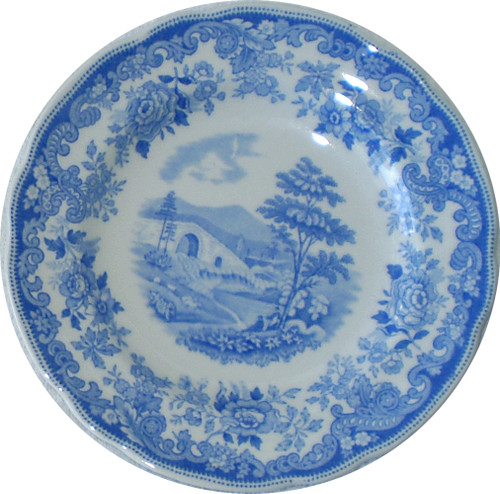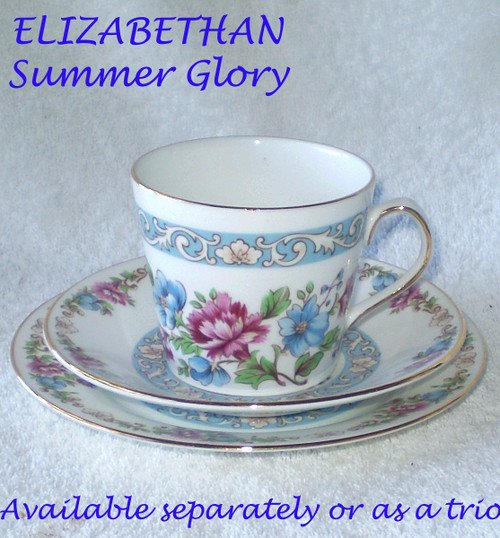HISTORY:
From time to time (actually quite a lot lately!) my wife has these moments ... "this has to find a new home" chinaware and sometimes what she gives me is just a bit "special", this Spode tableware definitely falls into this class. It is in fact a perfect example of mid 20th Century 'Spodeware'
If it is so special, why is she showing it the door? Her tastes have moved to OLD wares, I mean really old (and difficult to find) earthenware, china and porcelain - basically pre-1900's as far back in time as possible. When compared to those pieces, this is a 'youngster'!
Actually this is not chinaware, those pretty 'ladies' often trotted out for special occasions such as "High Tea" events, but in fact this is earthenware.
A few things make this quite special, first is the maker - William Copeland & Josiah Spode II began their operations way way back in the early 1800's, producing products of exceptional quality. Mr Spode passed away and Mr Copeland took the reins of the business until his retirement, the business then being run by his sons.
Secondly, this is decorated in the famous Colbalt Blue with the decoration applied using the special transferware techniques UNDER the glaze which the company had developed. Copeland & Spode were known for their innovations, this technique of using the Blue transferware underneath the glaze was first perfected by Josiah Spode I many years previously in the late 1700's - a first in the industry.
Interested how this was done? It seems that the designs, which were initially on engraved copper plates, was then transferred onto a gummed cotton paper, followed by transferring to the earthenware before glazing. This allowed for a considerable lowering of production costs and the production of high quality designs that were very durable. There is a far more in-depth history of this process development HERE
Thirdly, the company usually (but not always) made life a bit easier for the collector by impressing into the clay a coding system for dating purposes ... for sure, many other makers also helped with the dating of their products, such as Royal Doulton with their numbers to the side of the backstamp but very few actually impressed a code into the clay. Oh the joy of confidently estimating the production year and month!
Finally, this Spode/Copeland teaset is a prime example of their products before the Copeland's lost control of the company in 1966 - after that year there were many changes to the ownership and even to the extent that manufacturing went offshore (to China of course) in the 1990's
This teaset trio has the look of tableware from the 1950's period and the date impression code underneath confirms this.
Enough of the preamble ... let me tell you about these historically significant pieces
NOTE:
My wife has not given this one of her famous DLAT ratings (Darling, Look At This!) simply because this teaset is functional and not intended to be visually startling! Pretty, yes ... but a real table "show off" - not at all
COPELAND & SPODE Teacup - Saucer - Cake Plate Trio Teaset
(In the interests of the greatest flexibility for collectors, these are offered separately or as a trio if all pieces still remain available)
Circa 1950 (based on the backstamp layout design and the impressed T above 50 (T indicating August)
Made In England
Price indicated is for one off EACH PIECE, however if two or three pieces are selected then an automatic discount does apply in the checkout
Earthenware NOT Bone China
Opaque, meaning that you CANNOT see through the material when held up to the light
Pattern: SEVERN
The name refers to the River Severn (the longest river in Great Britain) although a partial view of this river is only on the side plate (central area of the plate) whereas all pieces have a Colbalt Blue coloured pattern comprising flower blooms, foliage and 'swirls', actually the pattern overall has a slight Oriental 'feel' to it.
Transfer decoration underneath the glazing, this is obvious when viewed very closely with a magnifying glass - the decoration looks just slightly 'blurred' as you are looking at the decoration through the top glazed surface.
Background colour in all pieces, is a soft Creamy White colour.
NO Gold gilding or other "frills" - Creamy White & Blue is the colour scheme here!
Shapes: All pieces have scalloped rims and notably the side plate is only ever so slightly larger diameter than the saucer.
The teacup has normal shaped sides i.e no fluting, pinching etc but it does also have decorative work inside the teacup mouth which extends well into the cup.
BACKSTAMP DETAILS:
Makers mark printed on the base of the teacup
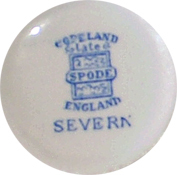
Makers mark printed on the base of the saucer
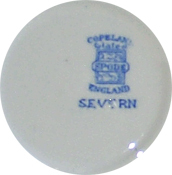
Makers mark printed on the base of the side plate
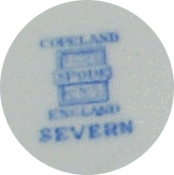
Note that the impressed date coding was difficult enough to read with the naked eye or magnifying glass but even more difficult in these photographs, in fact invisible! The coding that is impressed into the clay is ...
T
50
There are some other stampings but for the life of me I cannot figure out what they say
DIMENSIONS:
TEACUP: 95mm mouth x 55mm height (squat teacup with a wide mouth)
SAUCER: 155mm diameter
SIDE PLATE: 160mm diameter
COSMETIC CONDITION:
This first section of the condition report is universal to all three pieces, any difference or flaws are noted below this section
CLEAN
NO cracks
NO chips
NO discolouration observed to the Creamy White base colouring and the Blue decorative design, in all areas, including the teacup handle and rims of all pieces.
NONE of the pieces have any "stains", such as inside of the teacup - clean as!
NO damage or wear is apparent to the decorative work
NO significant knife or scratch markings to the saucer or more importantly, the side plate (important because here in the center sits the River Severn graphics!)
NOTE: While a traditional Colbalt Blue is usually a very rich deep Blue, the colour on all pieces is more gentle, more like a Ocean Blue. This does not appear to be a form of colour fade but the actual Blue used for the transfer of the design to the pieces.
NO crazing observed (Wet & Dry tested) EXCEPT I can see the very faintest of crazing on the saucer, topside. Very difficult to see and no discolouration but there none-the-less. The teacup and side plate do not show any signs of crazing.
NO fleabites on the teacup or side plate BUT the saucer does have one small underside fleabite which has not become discoloured.
Overall, a nice example of Spode - Copeland product from the 1950's and in very good condition considering its creation 75+ years ago
There are no additional comments about any individual piece

